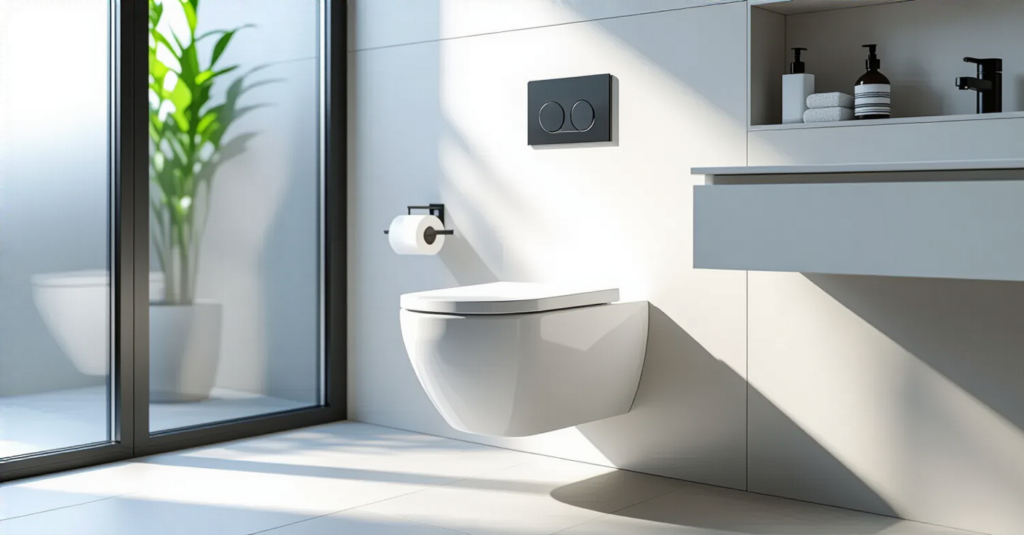Of course. Put that generic article aside. Let’s talk about how to make a tiny bathroom feel like a sanctuary, not a shoebox.
You know what people always ask me? They hold up their phone, show me a picture of a glamorous, sprawling bathroom from a magazine, and then gesture helplessly at their own little 5×7 foot space. “How do I get that feeling in this?” they ask. They think the secret is spending a fortune or knocking down walls.
It’s not. The secret is understanding that a small space is all about sensation. It’s about flow, light, and texture. It’s about tricking the eye, yes, but more importantly, it’s about creating a feeling of calm and quiet luxury, even if you can touch both walls at once. Most of what you read online is just a list of products. This is the real story of how to make it feel right.
Foundational Layout & Space Maximization
Okay, let’s get the big stuff out of the way. Before we even talk about plush towels or pretty soap, we have to make the bones of the room work for us. This isn’t about demolition; it’s about intelligent swaps that make the room breathe.
1. Install a Wall-Mounted Toilet to Free Up Floor Space
I know, a toilet isn’t the sexiest place to start, but trust me. A standard toilet eats up floor space like you wouldn’t believe. A wall-mounted one, where the tank is hidden in the wall, is the single biggest “wow” change you can make. Suddenly, you have this unbroken expanse of flooring flowing underneath it. The room doesn’t just look bigger; it feels bigger because your eye isn’t stopped by a chunky piece of porcelain.
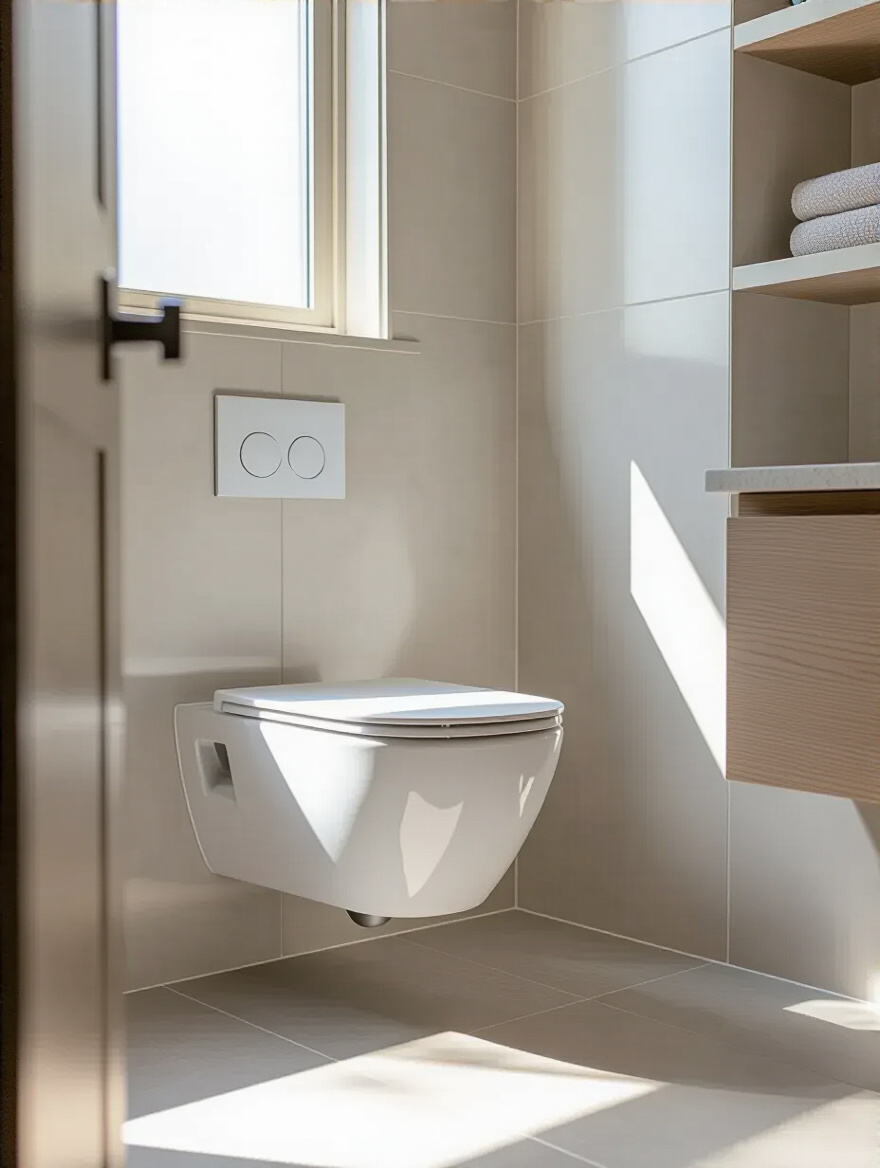
The real magic here is psychological. When your floor is clear, your brain registers the room as more open and, frankly, cleaner. That little bit of air underneath makes the whole space feel lighter. And can we talk about cleaning? Wiping a mop under a floating toilet instead of awkwardly scrubbing around a toilet base is a small, daily luxury that you will thank yourself for forever.
This is the kind of change that lays the groundwork for every other beautiful thing you want to add, letting the floor be a continuous canvas for a beautiful rug. Next up, let’s talk about what your hands touch most: the sink.
2. Choose a Corner Sink for Unobstructed Traffic Flow
Picture this: you’re sidling past the sink, hip-checking the vanity corner just to get to the toilet. It’s a tiny, daily annoyance that makes a space feel cramped and clumsy. The common mistake is thinking the sink has to go flat against the main wall. Tucking a sink into a corner is a brilliant move that reclaims that central walkway. It completely changes the geometry of the room.
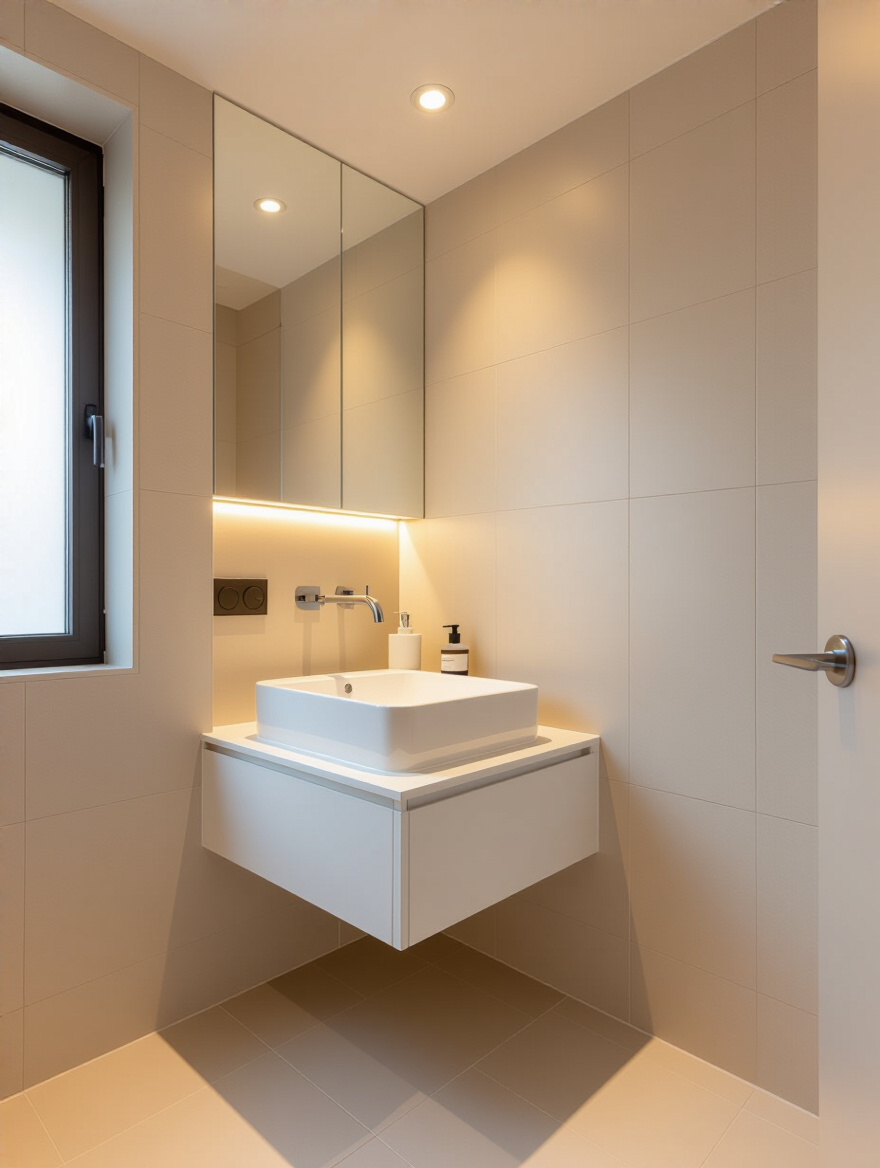
Instead of creating a bottleneck, a corner sink creates an open diagonal path. This immediately makes the bathroom feel more gracious and easier to move in. You can find beautiful, slim corner sinks that are either wall-mounted to free up even more floor space, or pedestal-style for a more classic look. It’s about creating flow and eliminating those little moments of friction in your day.
Getting the big obstacles out of the main traffic path is key. Another huge offender? The door itself.
3. Opt for a Pocket or Sliding Door to Save Opening Clearance
The single most space-hungry element in most small bathrooms is the door. A traditional hinged door swings into the room and eats up about nine square feet of usable space. You can’t put anything there. You can’t stand there. I once had a client who couldn’t even fit a plush bath mat in her bathroom because the door would scrape against it. That’s just sad.
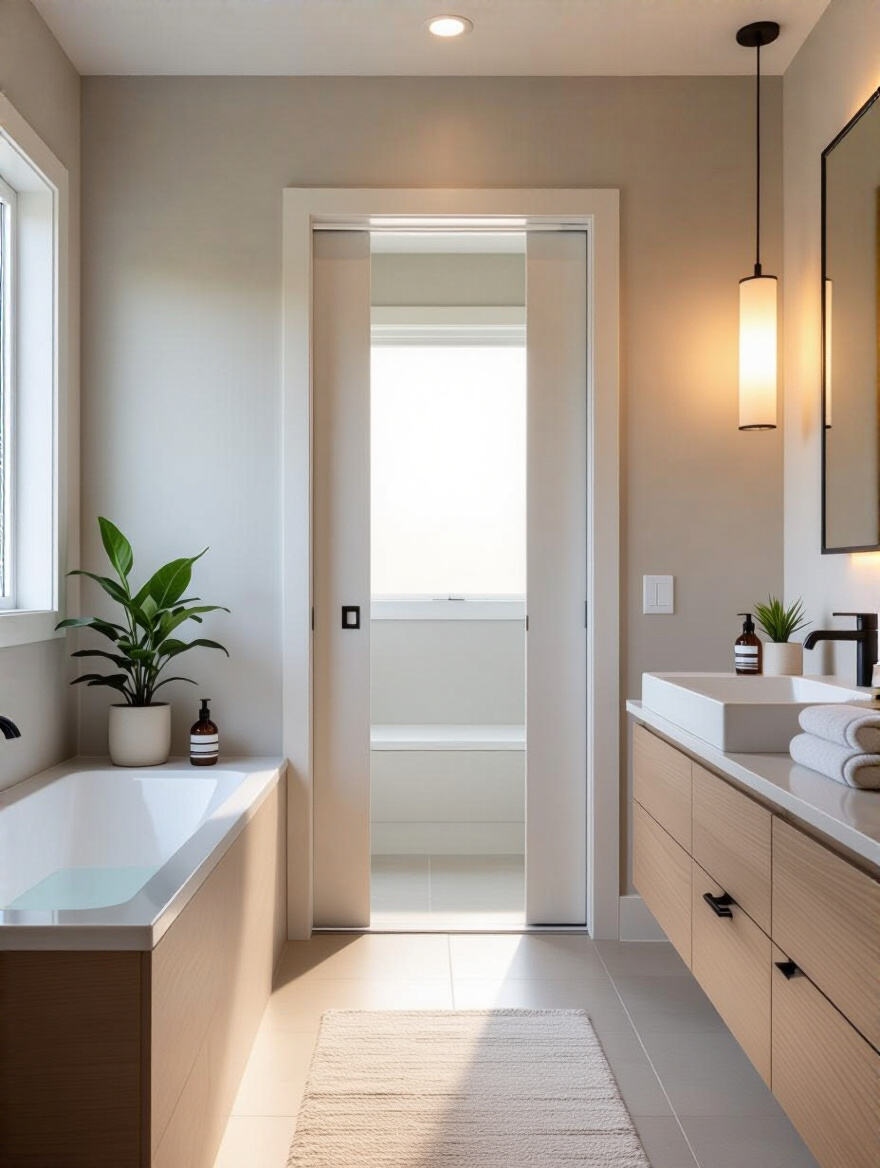
Switching to a pocket door that disappears into the wall, or a Sliding barn door that glides alongside it, is a total game-changer. It reclaims all that stolen real estate. Suddenly, the wall where the door used to swing open is usable space for towel hooks or a slim cabinet. The feeling of not having to step back to let the door open or close gives you a sense of freedom you didn’t know you were missing.
Once you’ve sorted the entry, the biggest space-hog inside the room is usually the tub.
4. Convert a Bathtub to a Walk-In Shower for Visual Openness
Let’s be honest. How often do you actually take a bath? For most people, a bulky bathtub is just a 15-inch-high wall you have to climb over every single day to take a shower. It visually chops the room in half and makes it feel crowded. Taking that tub out and replacing it with a walk-in shower with a clear glass panel is like knocking down a wall without actually knocking down a wall.
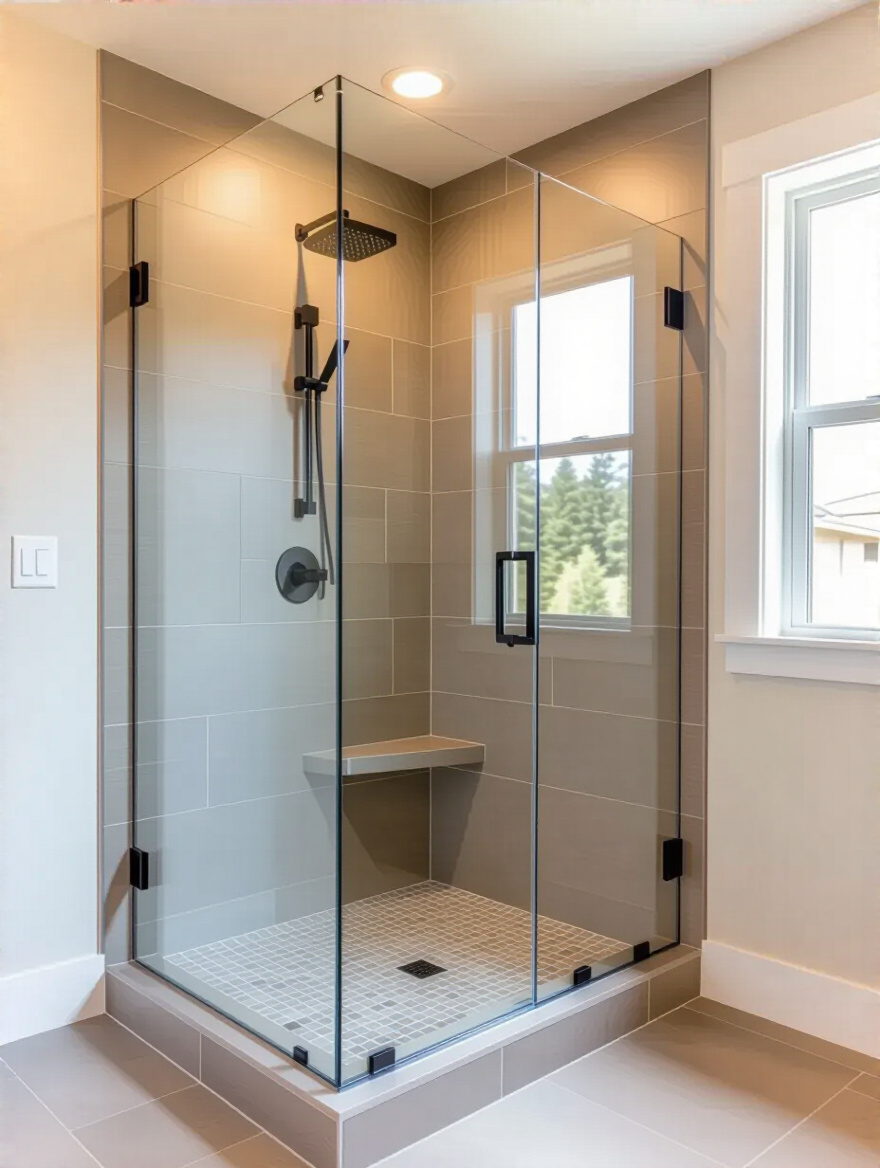
Your eye can suddenly travel all the way to the back of the shower, making the entire bathroom feel deeper and more expansive. If you can make it a curbless, zero-threshold shower where the bathroom floor tile flows seamlessly right into the shower, the effect is even more dramatic. It creates one continuous, beautiful surface that feels incredibly luxurious and open.
This continuous flow is a theme we’ll come back to. Let’s apply that same principle to the vanity.
5. Utilize a Floating Vanity to Create Underspace Visual Flow
Just like the wall-mounted toilet, a floating vanity is another one of my secret weapons. Mounting your vanity to the wall so it hovers above the floor gets rid of the blocky, heavy feeling of a traditional cabinet. It lets the flooring continue underneath, which, again, tells your brain the room is larger than it is. It makes the entire vanity feel lighter, more like a piece of furniture than a bulky built-in.
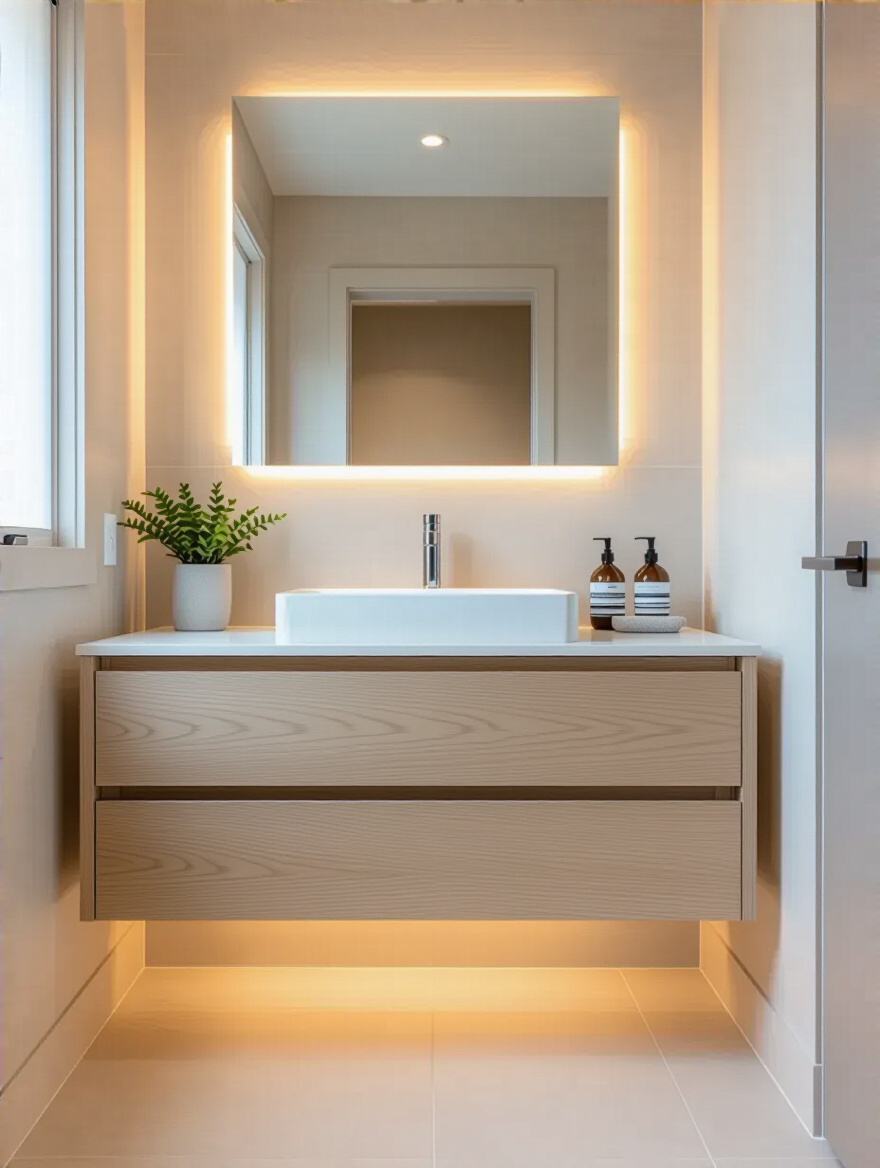
This is also a beautiful opportunity to play with texture in an unexpected way. The space underneath is the perfect spot to tuck a gorgeous, woven basket for spare towels or a small wooden stool. It’s a little curated moment that adds softness and personality, turning what could be dead space into a design feature. You get your storage, but you also get a feeling of airiness.
But what if you don’t need all that storage? There’s an even sleeker option.
6. Select Slim or Pedestal Sinks to Preserve Floor Area
Here’s a piece of BS I hear all the time: “You need a big vanity for storage.” No, you don’t. Often, a big vanity just becomes a cluttered cavern of half-empty bottles. Choosing a simple, elegant pedestal sink or a slim, wall-mounted basin preserves the maximum amount of floor space and forces you to be intentional about what you keep.
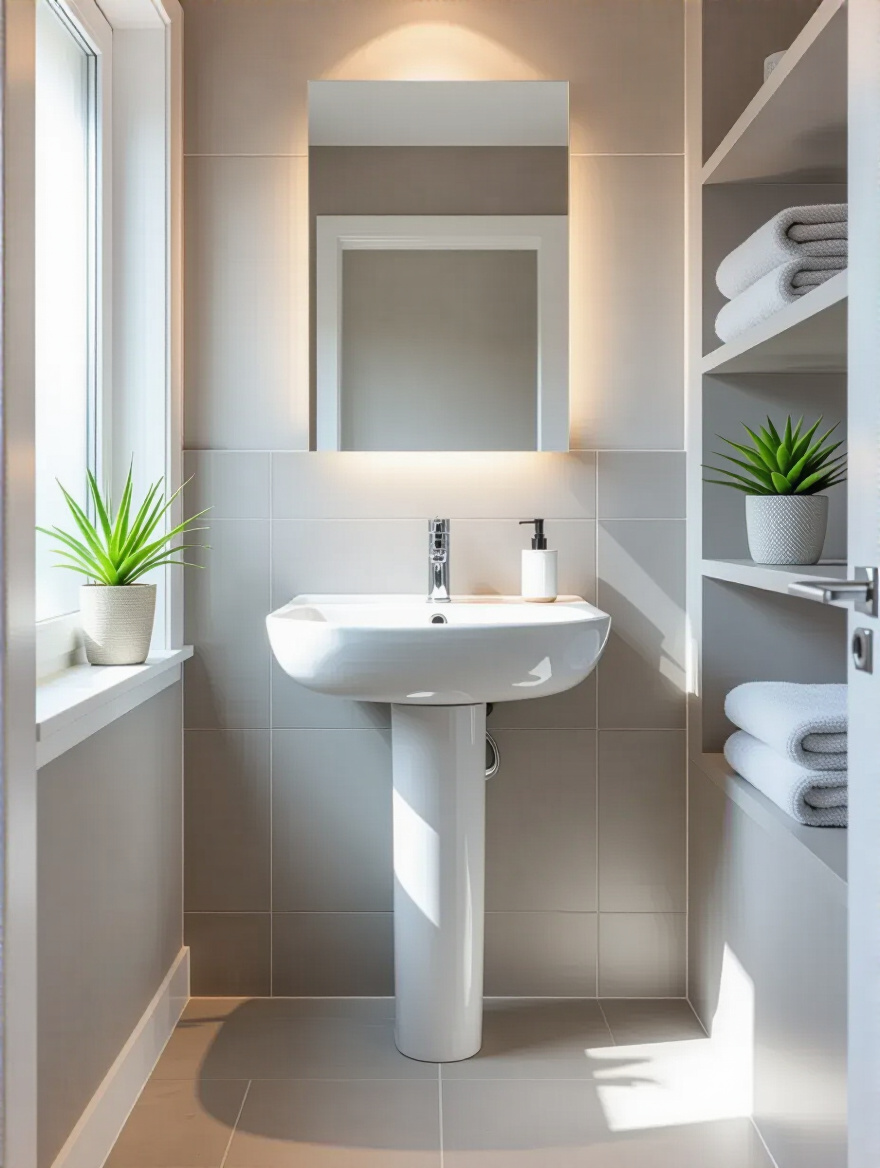
This choice creates an incredible sense of openness and lets beautiful tilework or wall finishes be the star. The key is to then be smart about storage elsewhere—which we’ll get to in a minute. This isn’t a sacrifice; it’s a trade-off for a feeling of serene, uncluttered space. It gives you a reason to buy that beautiful lidded basket or install a mirrored medicine cabinet.
And on that note, let’s talk about how to cleverly hide all your stuff.
Intelligent Storage & Decluttering Solutions
A serene bathroom is an organized one. Clutter is the enemy of calm, especially in a small space where it just shouts at you. The trick isn’t to have less stuff, it’s to give every single thing a smart, invisible home.
7. Integrate Recessed Shelving into Wall Cavities
This is my absolute favorite trick. The space between the studs in your walls is about four inches deep—and it’s pure, untapped potential. Instead of adding shelves that stick out into the room, build them into the wall. A recessed niche next to the sink or above the toilet is the perfect spot for pretty perfume bottles, rolled-up washcloths, or a small plant.
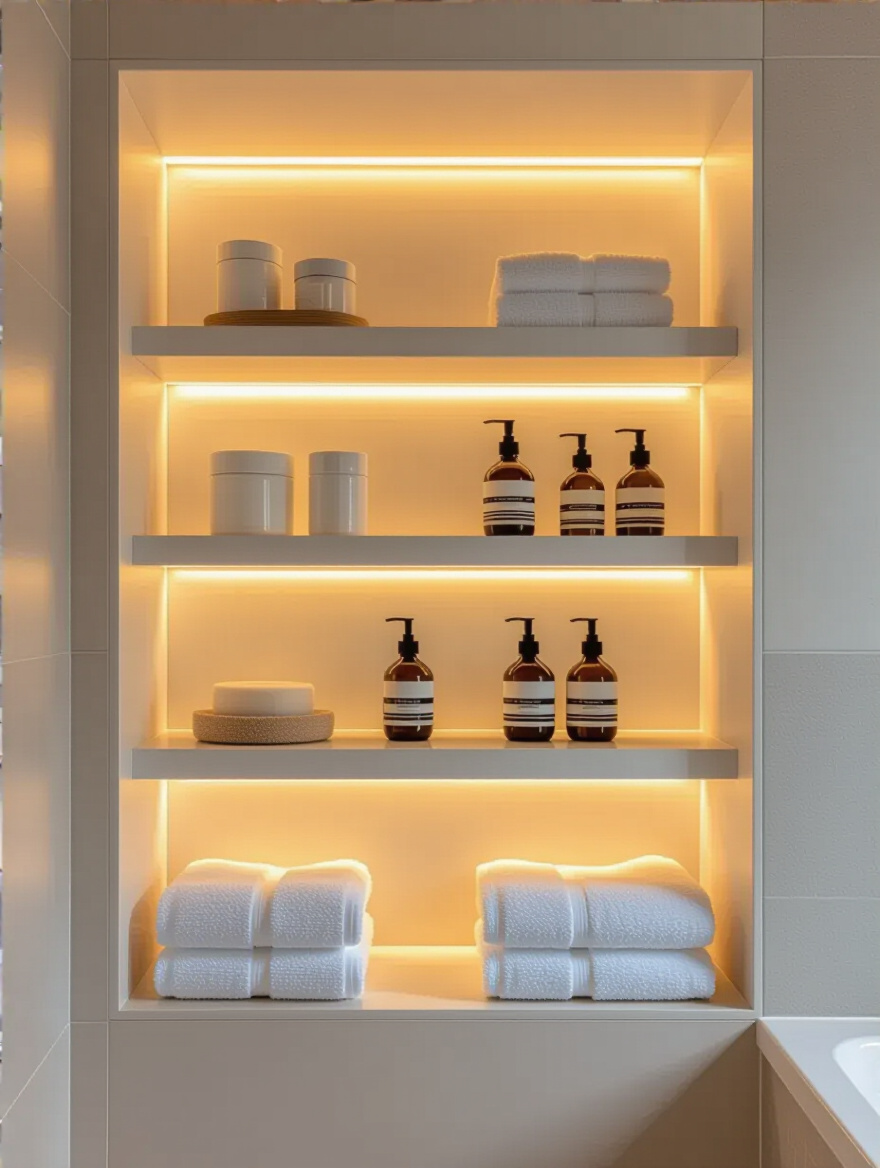
It provides storage without taking up a single inch of air or floor space. In a shower, a recessed niche is non-negotiable. It gets rid of those rusty, clunky shower caddies and turns your shampoo bottles into a tidy, organized display. It feels custom, intentional, and incredibly high-end, like a little jewel box built right into your wall.
We’re going to keep thinking vertically, because when you can’t build out, you build up.
8. Add a Tall Vertical Storage Cabinet for Height Utilization
Look up. Most people have tons of unused wall space above eye level. A tall, narrow cabinet—sometimes called a linen tower—is the perfect way to harness that height. It draws the eye upward, which has the lovely effect of making the ceiling feel higher and the room feel grander. It has a tiny footprint but offers a massive amount of storage.
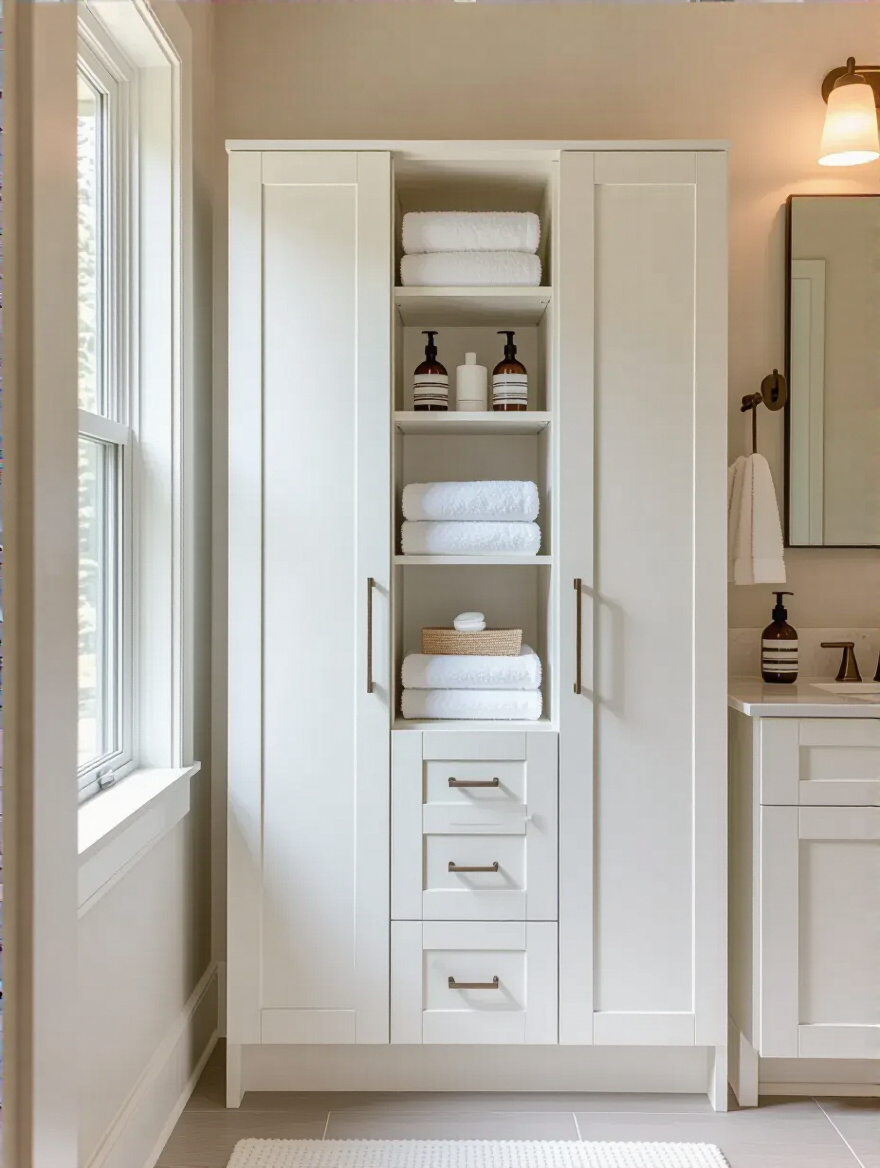
This is where you hide the “ugly but necessary” things: extra toilet paper, cleaning supplies, the bulk bottle of mouthwash. Get it all off the countertop and behind a closed door. The result is instant visual calm. You’re trading a tiny bit of floor space for a huge gain in organized, concealed storage, and that is a trade you should make every time.
Don’t have space for a tower? There’s still prime real estate you’re probably ignoring.
9. Install Over-the-Toilet Shelving or a Storage Unit
The wall above the toilet is the most underutilized space in almost every bathroom. It is begging for some love! A simple set of floating shelves or a freestanding shelving unit (often called an “etagere”) can transform this dead zone into a powerhouse of storage and style. This is the spot for things you need handy but not necessarily on the counter.
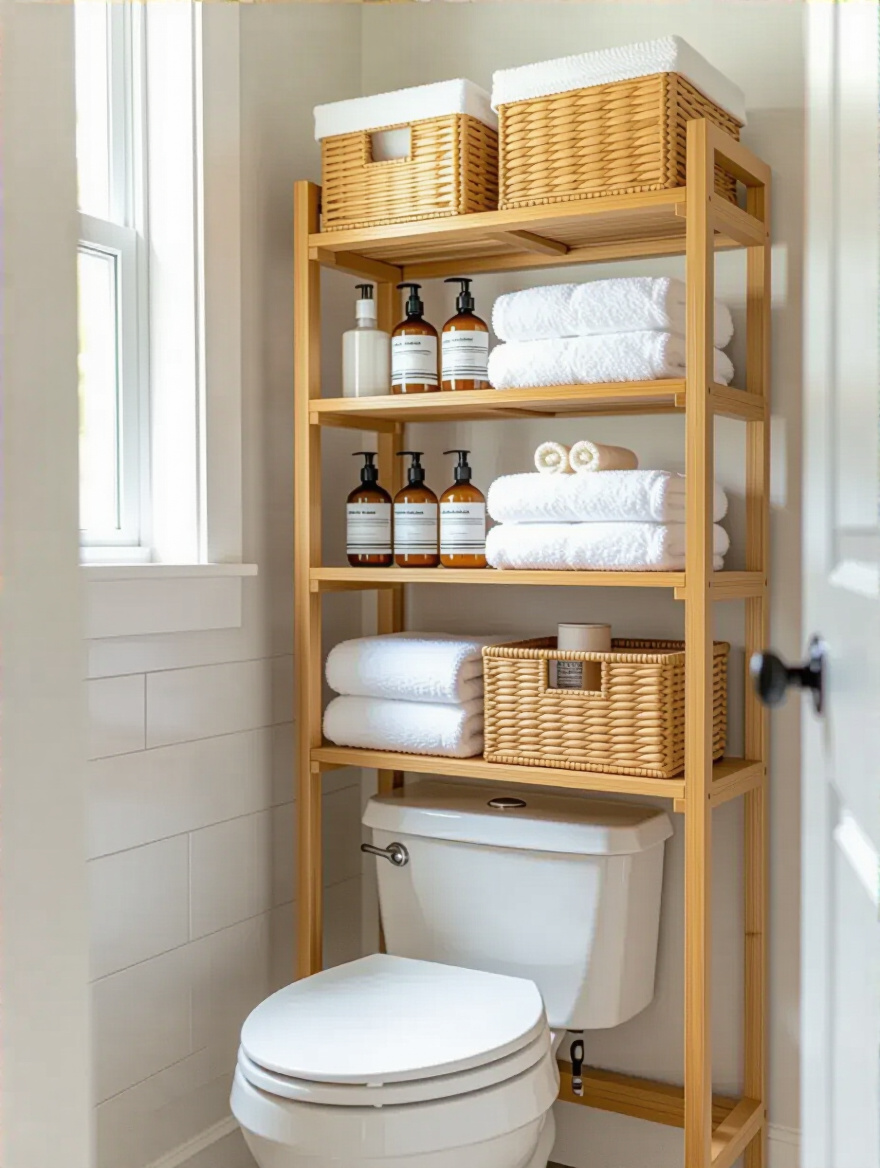
Use beautiful baskets or canvas bins to corral smaller items. One basket for extra hand towels, one for toiletries, one for spare soap. It immediately looks organized and intentional. This isn’t about just stacking stuff; it’s about curating. You get bonus points if the texture of the baskets adds a soft, organic feel to the room.
But don’t stop there. Look higher.
10. Mount Floating Shelves Above the Doorframe for Extras
Here’s a spot almost no one thinks about: the space right above your doorframe. It’s totally out of your direct line of sight, making it the perfect spot for deep storage. A single floating shelf installed here is ideal for things you don’t need often—like a basket of extra guest towels or travel-sized toiletries.
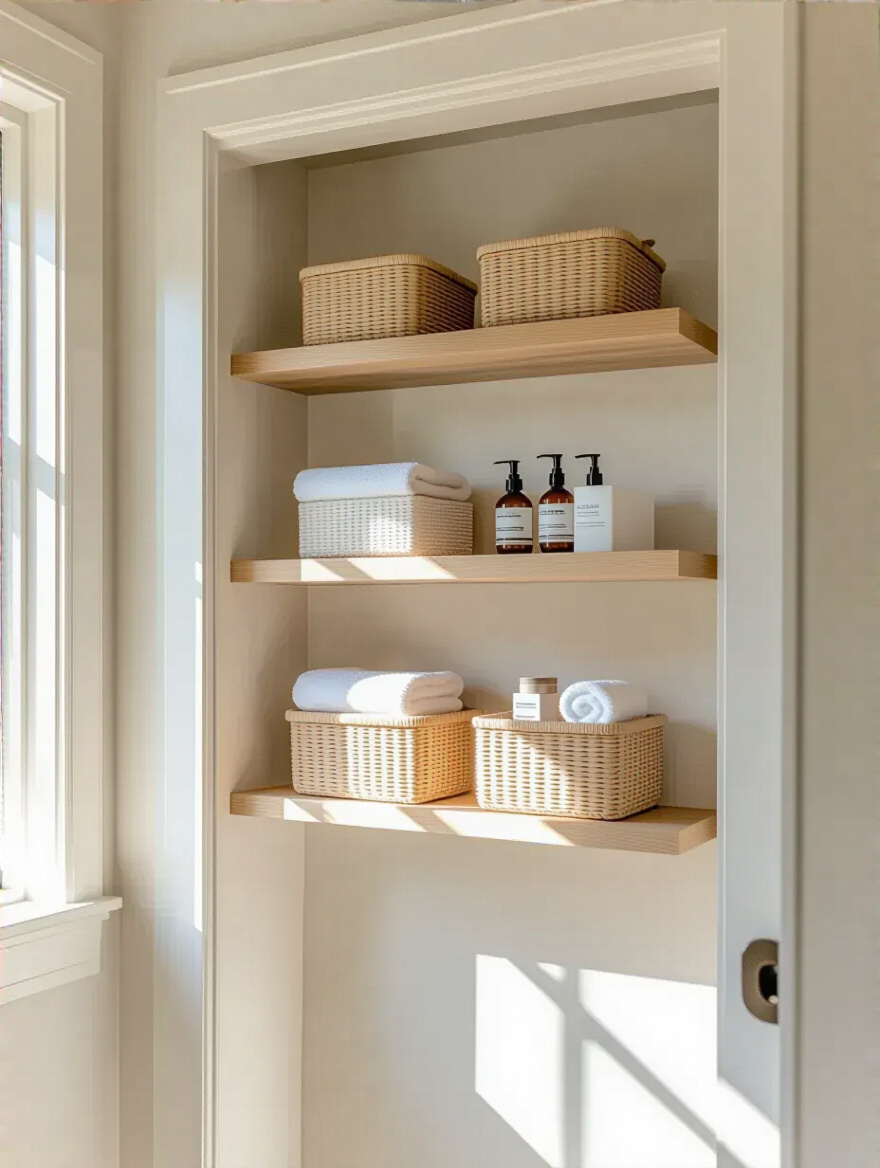
It gets things up and out of the way, freeing up more accessible cupboards for your daily essentials. And because it’s so high up, it doesn’t add to the visual clutter of the room. It’s a whisper of storage, not a shout. Just make sure you mount it securely into the wall studs!
And speaking of doors, let’s flip it around.
11. Utilize Behind-the-Door Hooks and Organizers Effectively
The back of your bathroom door is your secret weapon. Don’t just stick a single hook on it for a damp towel. Think bigger! A full-length, over-the-door organizer with multiple pockets can hold hair dryers, brushes, sprays, and all sorts of supplies. Or, install a beautiful row of sturdy, elegant hooks to hang plush robes and towels.
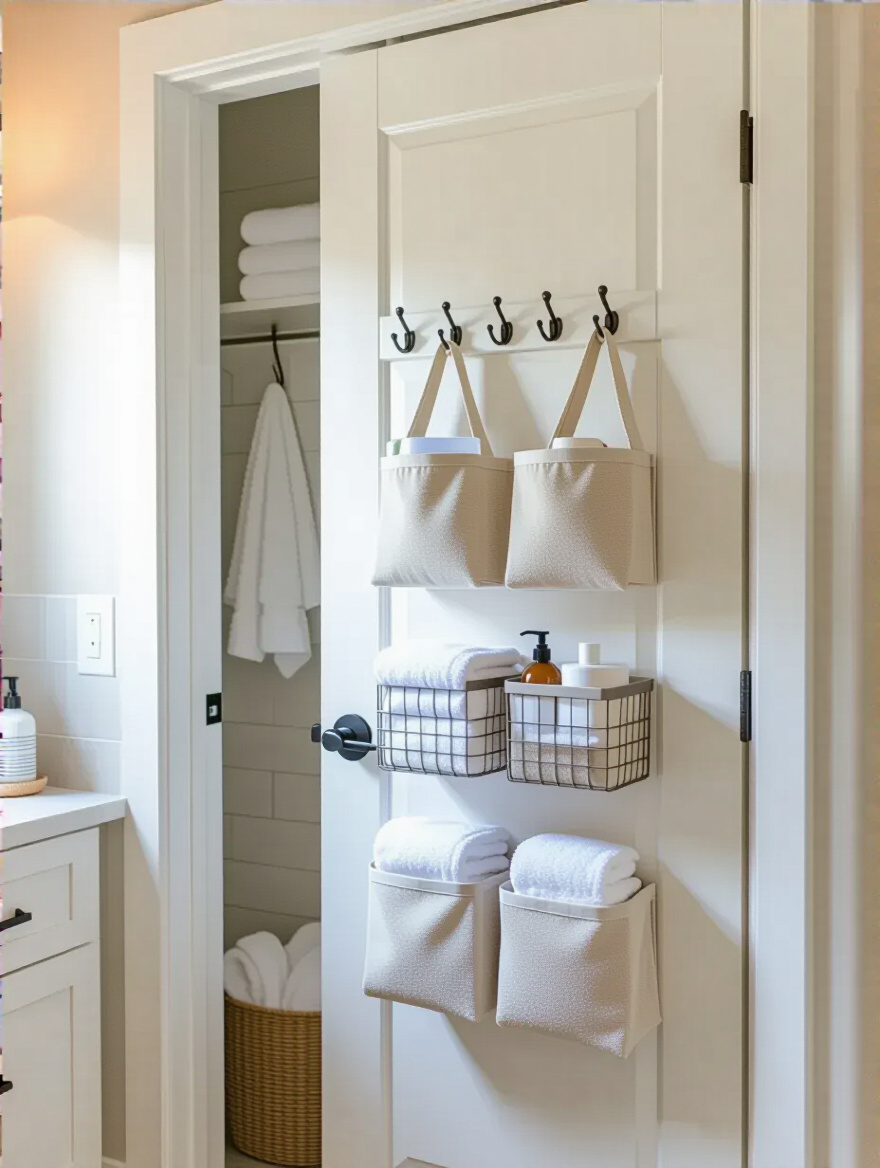
My confession: I used to use cheap plastic over-the-door hooks and they always felt flimsy and sad. Investing in a solid wood or metal rack made a world of difference. It felt intentional. Suddenly, the back of the door became a functional and beautiful part of the room’s design, a perfect place to display a gorgeous linen robe.
Now let’s apply that same streamlined thinking to the shower.
12. Install Built-In Shower Niches to Eliminate Caddy Clutter
We touched on this before, but it deserves its own moment. Please, I am begging you, throw away the hanging shower caddy. Nothing makes a bathroom feel smaller and more cluttered than that wire rack overflowing with bottles. A built-in niche is the solution. It’s clean, integrated, and gives your daily products a proper, dignified home.

When you’re tiling your shower, have your contractor frame out one or two niches. Make one tall enough for your largest shampoo bottle. The feeling of reaching into a clean, tiled niche for your soap instead of fumbling with a rusty caddy is a small, profound upgrade to your daily ritual. It elevates the entire experience from utilitarian to spa-like.
With everything tucked away, it’s time to make the space shine—literally.
Illumination & Visual Expansion Strategies
Light is your best friend in a small space. It can bend, bounce, and stretch a room in ways that physical renovations can’t. This section is all about using light and reflection to create an illusion of boundless space.
13. Install a Large Frameless Mirror to Visually Double Space
This is the oldest trick in the book because it works. A big mirror is like adding a window to a windowless room. A large, frameless mirror—one that goes from the top of your backsplash all the way to the ceiling, or spans the entire wall—is even better. By getting rid of the frame, you remove the visual boundary, and the reflection seems to merge seamlessly with the room itself.

The effect is magical. It will bounce every bit of light around, making the entire bathroom feel brighter and more alive. It reflects the textures you’ve so carefully chosen—the weave of your towels, the leaves of a plant—doubling their impact. Don’t be timid. Go as big as you can. It’s the single most effective way to make a small room feel twice its size.
To get the most out of your mirror, you need to give it something beautiful to reflect.
14. Maximize Natural Light with Sheer or Frosted Window Film
If you’re lucky enough to have a window, don’t choke the life out of it with heavy blinds or a dark curtain. Natural light is precious. To maintain privacy while letting the light flood in, use frosted or reeded window film. It’s inexpensive, easy to apply, and it transforms harsh, direct sunlight into a soft, ethereal glow.

It obscures the view completely while still allowing 80-90% of the light to pass through. The quality of this diffused light is just gorgeous. It makes everything in the room look softer and feel calmer. It’s the difference between being under a harsh spotlight and being in a room filled with gentle, ambient sunshine.
Of course, not every bathroom has a window, which is why your artificial light plan is so important.
15. Choose Recessed Lighting Fixtures for Uncluttered Ceilings
Get rid of that single, sad “boob light” in the center of the ceiling. A hanging fixture visually lowers the ceiling and creates a focal point of clutter. Instead, opt for recessed can lights. They disappear into the ceiling, creating a clean, smooth plane that makes the entire room feel taller.
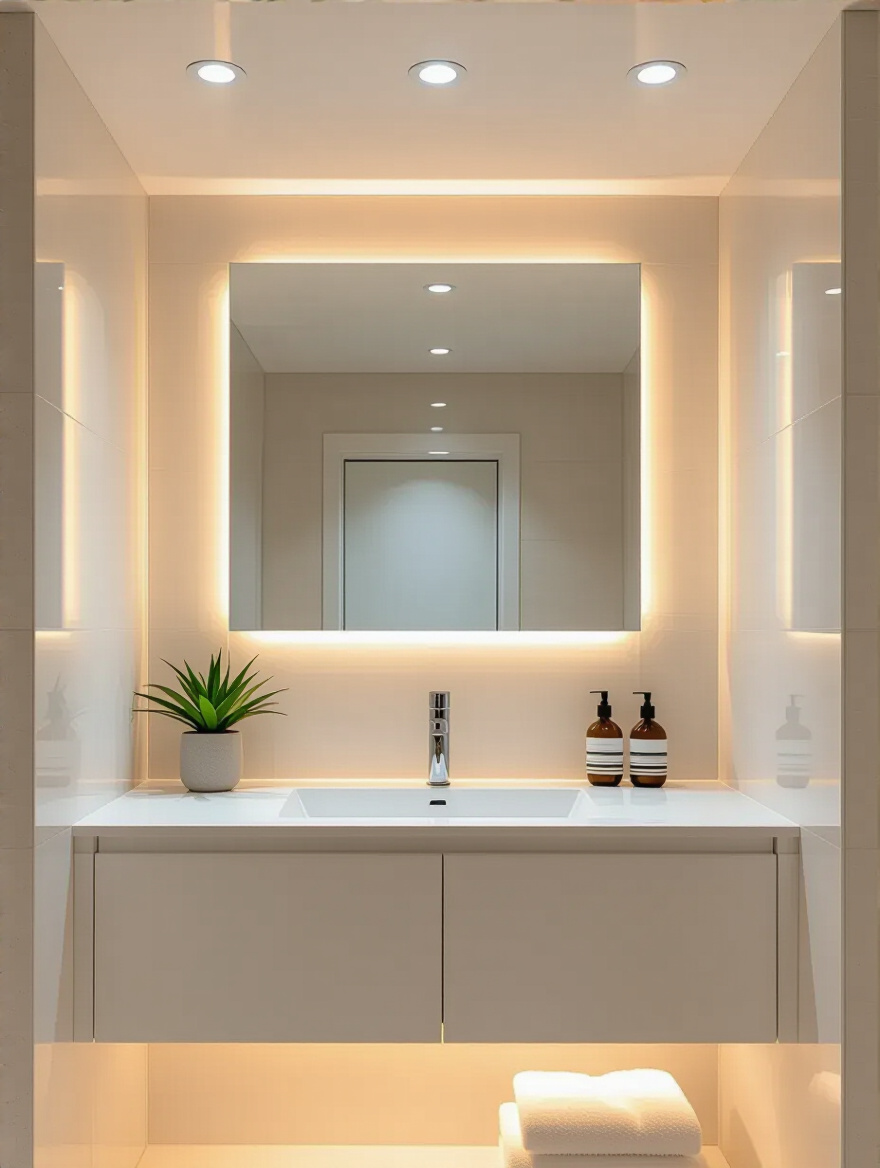
The trick is to use several of them and place them strategically. A common mistake is to line them up down the middle like a runway. Instead, place some closer to the walls. This creates a “wall-washing” effect, where the light grazes down the surface of your walls, highlighting any texture and making the boundaries of the room seem to recede. It makes the space feel wider and more atmospheric.
This general light is great, but it’s not enough for the most important spot in the room.
16. Add Task Lighting Around Mirrors for Better Visibility
Can we talk about why everyone gets this wrong? Putting a single light fixture above the mirror is a recipe for disaster. It casts monstrous shadows under your eyes, nose, and chin, making you look ten years older and twice as tired. It’s the worst possible light for getting ready. It’s my ultimate pet peeve.
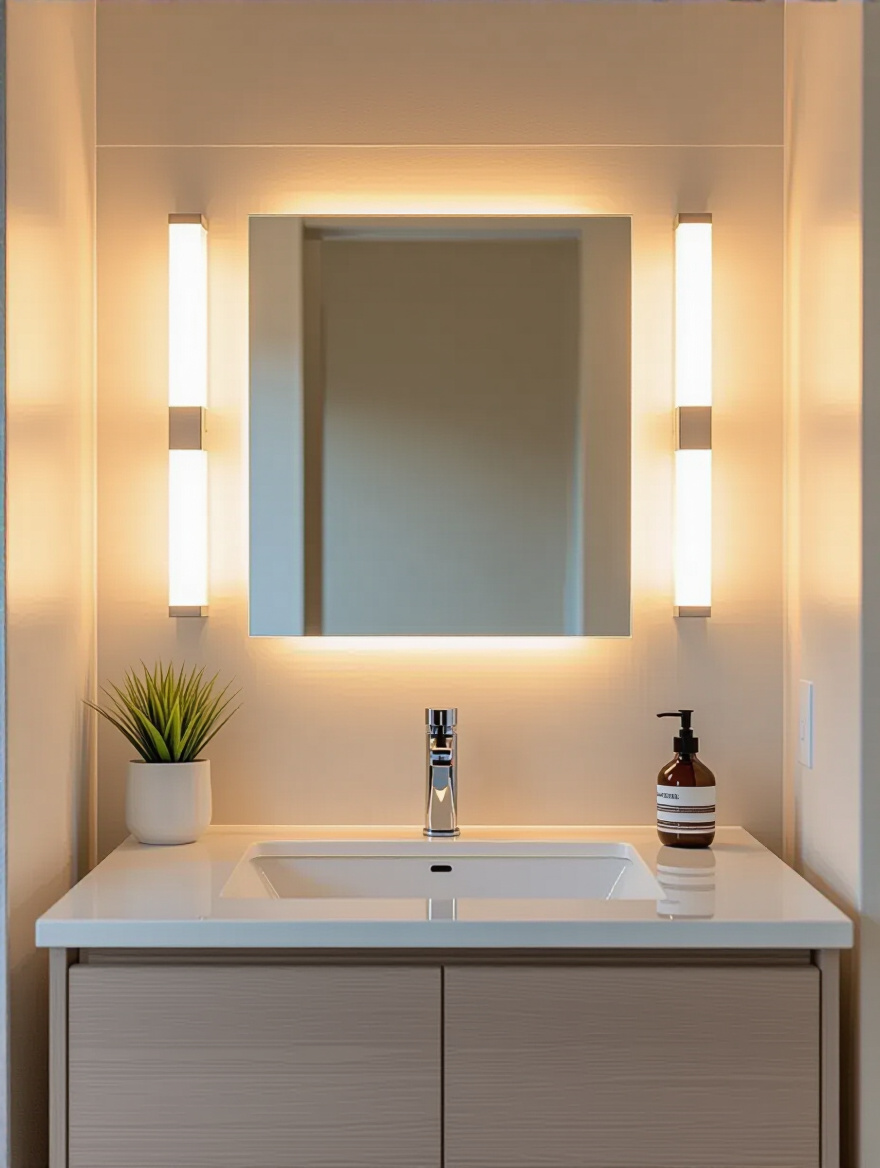
The solution is to light the face, not the top of the head. Place lights on either side of the mirror, at roughly eye level. This can be two beautiful sconces or a mirror with integrated LED strips on the sides. This cross-illumination cancels out all the shadows, providing clean, even, flattering light. And always, always put it on a dimmer. Bright for makeup, soft and low for a relaxing evening routine.
Light needs something to bounce off of, which brings us to another critical surface.
17. Opt for a Glass Shower Door for an Open, Continuous Look
Like I said before, opaque shower curtains are space-killers. They act like a solid wall, stopping the eye and cutting off a huge chunk of your bathroom. A clear glass door or panel makes that visual barrier disappear. It allows light—and your line of sight—to travel all the way to the back wall of the shower.
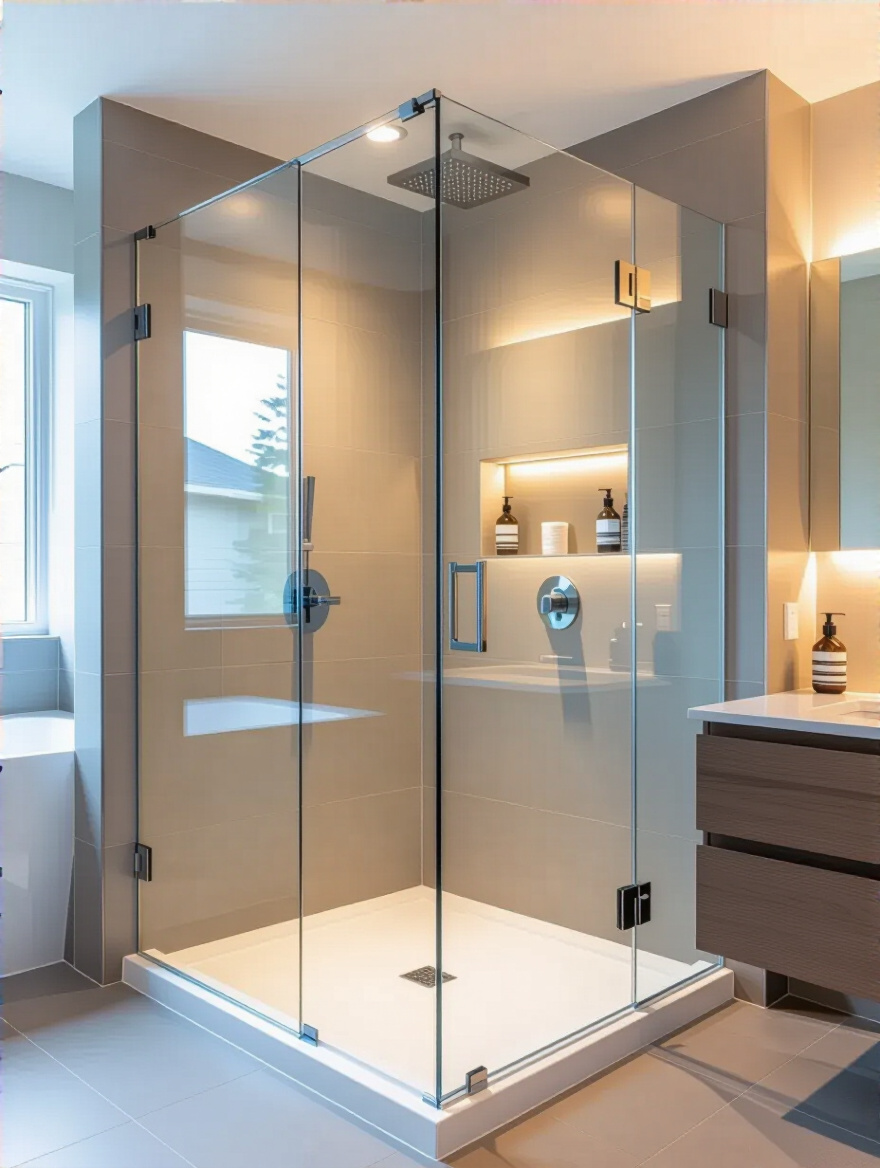
People always tell me, “But I don’t want to clean it!” Here’s my shortcut: keep a small, attractive squeegee in the shower. A quick 10-second wipe-down after you shower prevents water spots from ever forming. It’s a tiny ritual that keeps your bathroom feeling bright, open, and sparkling. The visual reward is more than worth it.
The final piece of the light puzzle is the biggest surface of all: the walls.
18. Use Light-Colored Paint Tones to Reflect Ambient Brightness
This might seem obvious, but it’s crucial. Dark colors absorb light and make walls feel like they’re closing in on you. Light colors do the opposite; they bounce light around the room, making the whole space feel airy and expansive. Think of it like fabric: a heavy, dark velvet curtain feels enclosing, while a white linen sheet feels light and breezy. Your wall color works the same way.
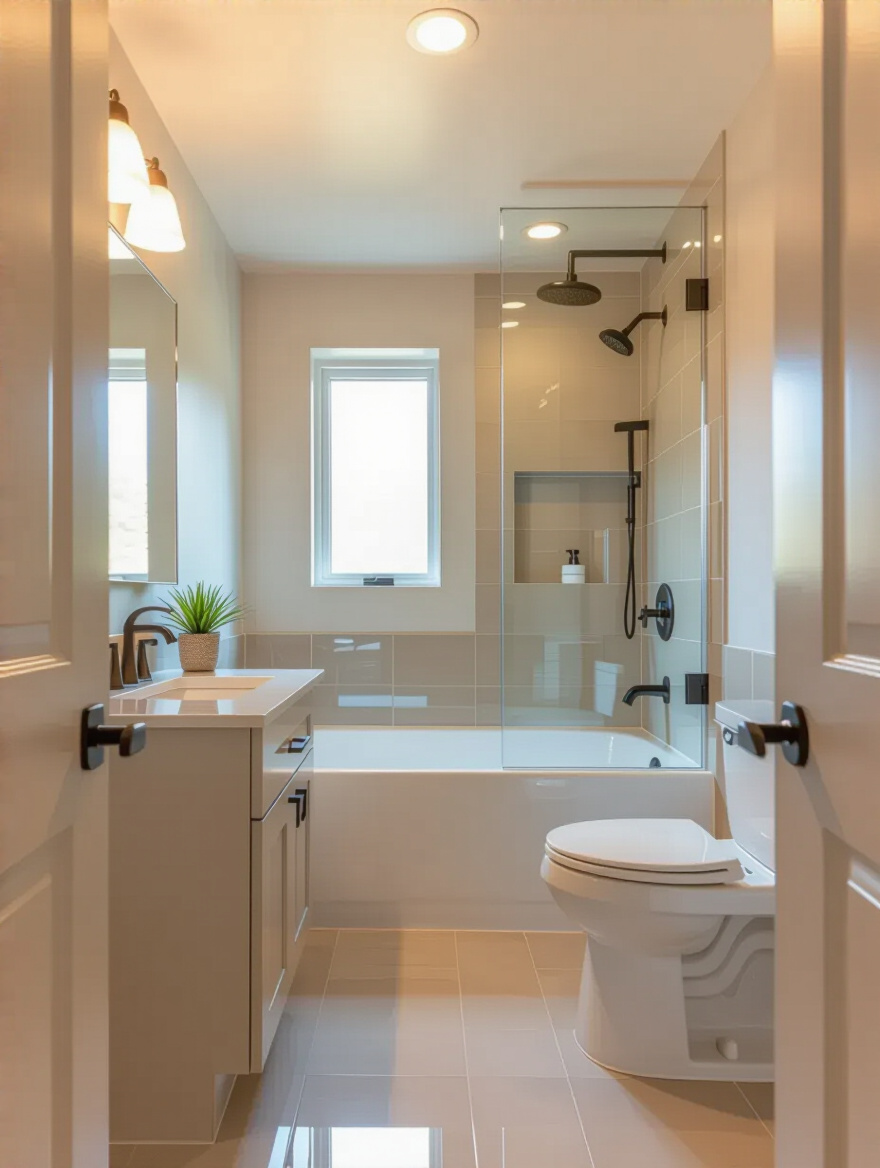
Look for colors with a high Light Reflectance Value, or LRV. This number (usually on the back of the paint chip) tells you how much light a color reflects. Anything over 60 is good; over 70 is great. My secret pro tip? Paint the ceiling the same light color as the walls, or even a shade lighter. It erases the boundary between wall and ceiling, making the whole room feel taller and more seamless.
Now that the room is bright and open, let’s add the final layers of personality and texture.
Aesthetic Touches & Smart Styling
This is my favorite part. The foundation is set, the light is perfect. Now we get to play with the tactile details that make a bathroom feel like a personal retreat. This is where textiles and curated objects turn a functional space into a beautiful one.
19. Select Large-Format Floor Tiles for Fewer Grout Lines
It seems counterintuitive, but in a small room, you should use large tiles. Small tiles mean lots of grout lines, which creates a busy, grid-like pattern on the floor that makes it feel choppy and small. Large tiles—like 12×24 or 24×24 inches—mean fewer grout lines and a more serene, continuous surface.
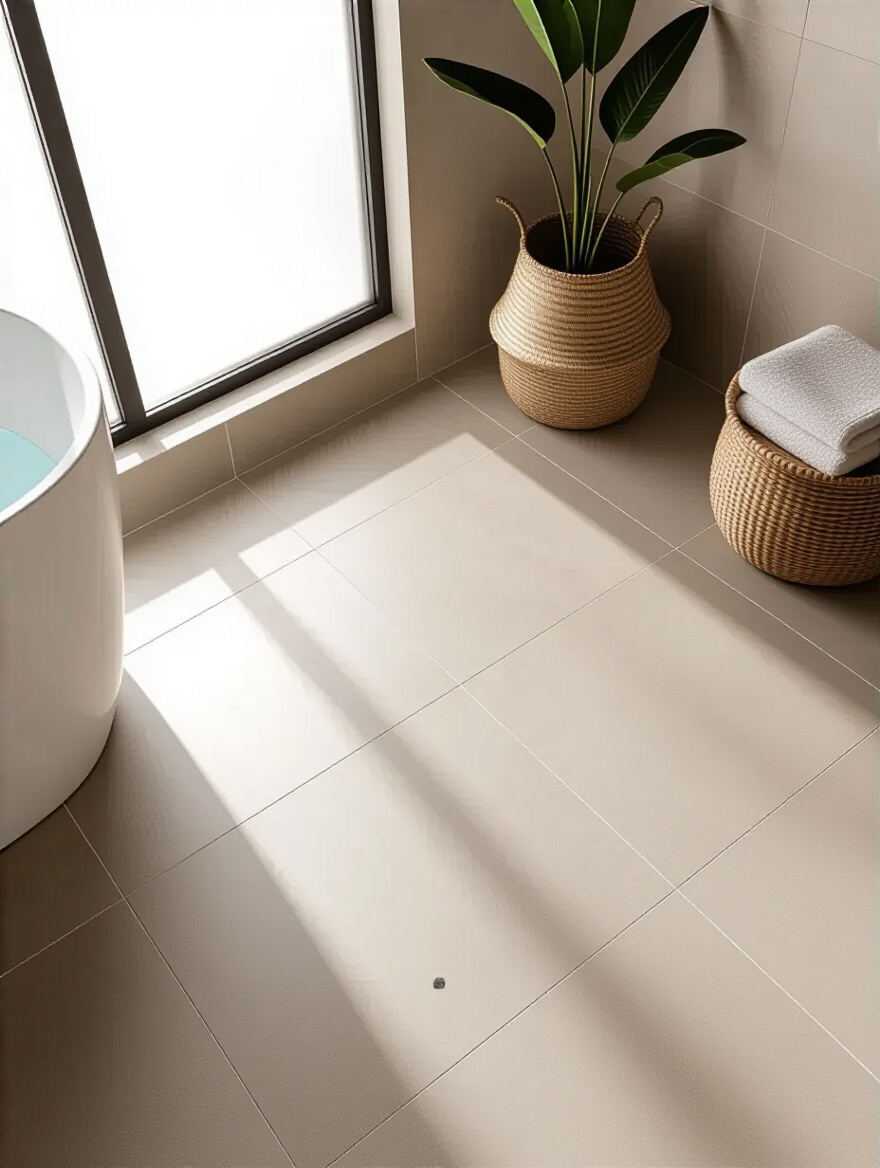
Think of your floor as a single piece of fabric. The fewer seams, the more expansive it looks. This effect is amplified if you use a grout color that closely matches the tile. The goal is to make the grout lines disappear as much as possible, creating a clean, unbroken canvas underfoot. This allows any rug you place on top to truly shine.
Now let’s zoom in on the smaller details.
20. Incorporate Minimalist Faucets and Hardware for Clean Lines
In a small space, every single object carries more visual weight. Ornate, fussy hardware can quickly look cluttered. Opt for faucets, towel bars, and cabinet pulls with simple, clean lines. Think minimalist shapes and unfussy designs. A single-handle faucet looks sleeker than a two-handle one. A simple, straight towel bar looks cleaner than a scrolled, decorative one.
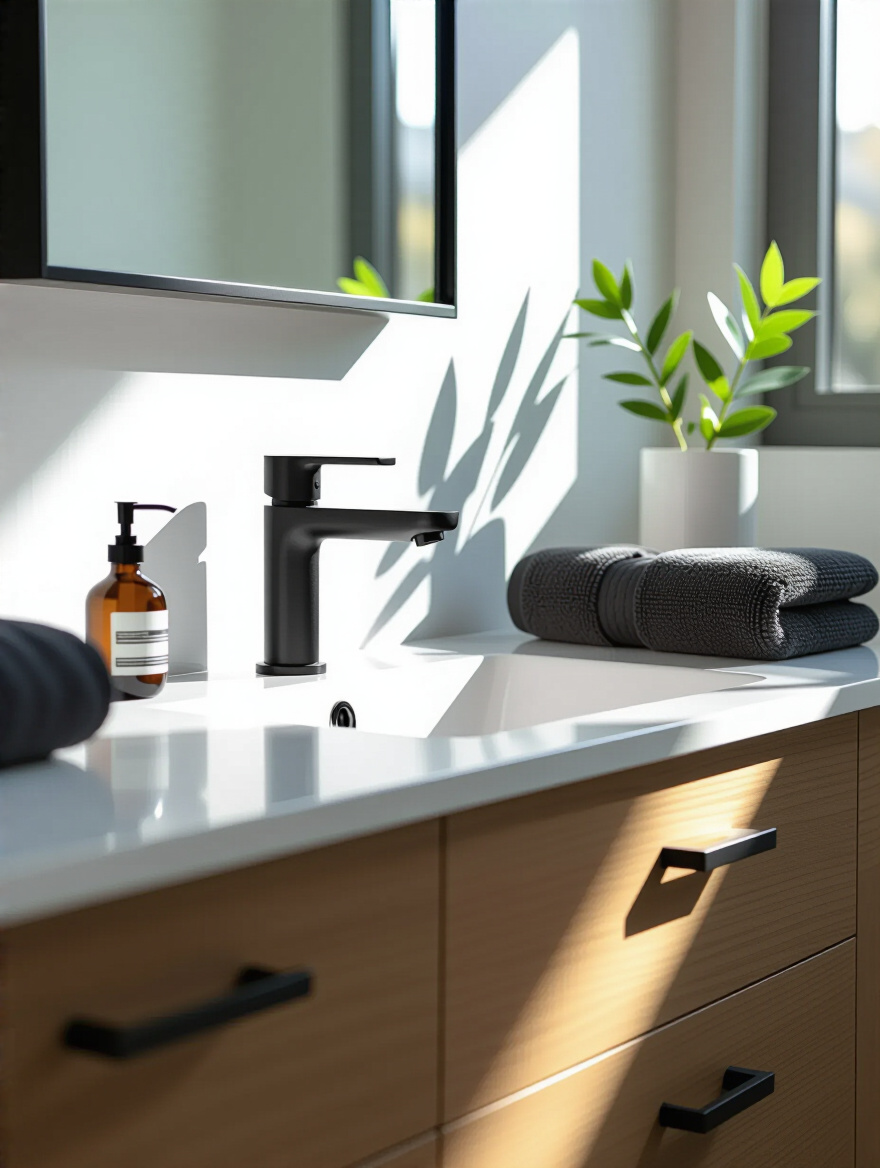
The goal here is to reduce visual noise. These elements should be like quiet, elegant punctuation in the room, not the main headline. Choosing one consistent finish for all your metal—like matte black, brushed brass, or polished chrome—creates a cohesive, pulled-together look that feels intentional and calming.
Now, let’s add a touch of life.
21. Add Small Plants for Freshness and a Touch of Greenery
Every room needs something alive in it, especially a bathroom, which can be full of hard, sterile surfaces. A small plant is the perfect way to add a touch of softness, a pop of color, and a bit of organic texture. You don’t need a giant fiddle-leaf fig; a tiny succulent on a windowsill or a trailing pothos on a high shelf is all it takes.
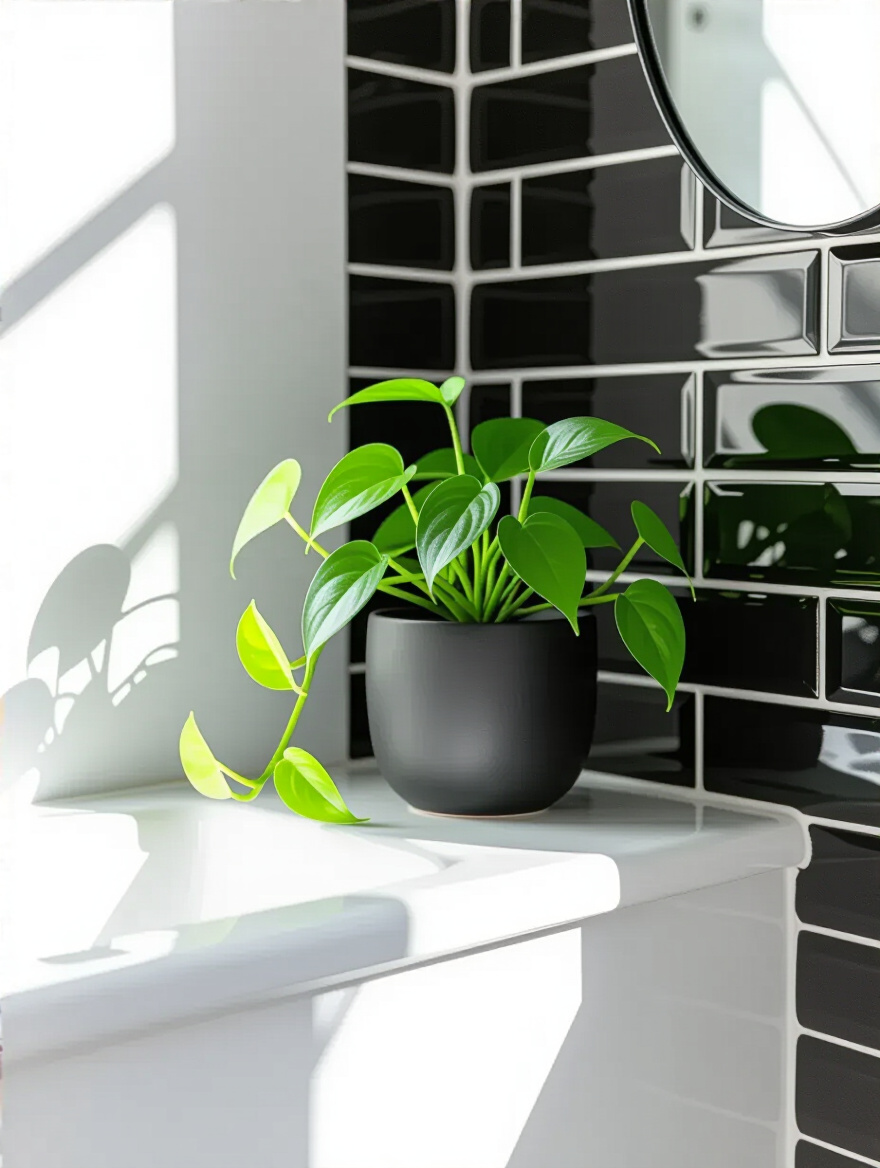
Choose plants that love humidity and can tolerate lower light, like snake plants, ZZ plants, or ferns. A little bit of green makes a space feel healthier and more vibrant. It’s a tiny detail that signals life and care, turning a purely functional room into a nurturing one.
This pop of color is an exception to my next rule.
22. Utilize Uniform Color Schemes for a Cohesive Feel
The fastest way to make a small space feel chaotic is to fill it with lots of competing colors. The most effective way to make it feel serene and expansive is to stick to a tight, uniform color palette. This doesn’t mean it has to be boring! It means you pick one main color family—like soft grays, warm whites, or tranquil blues—and you layer it.
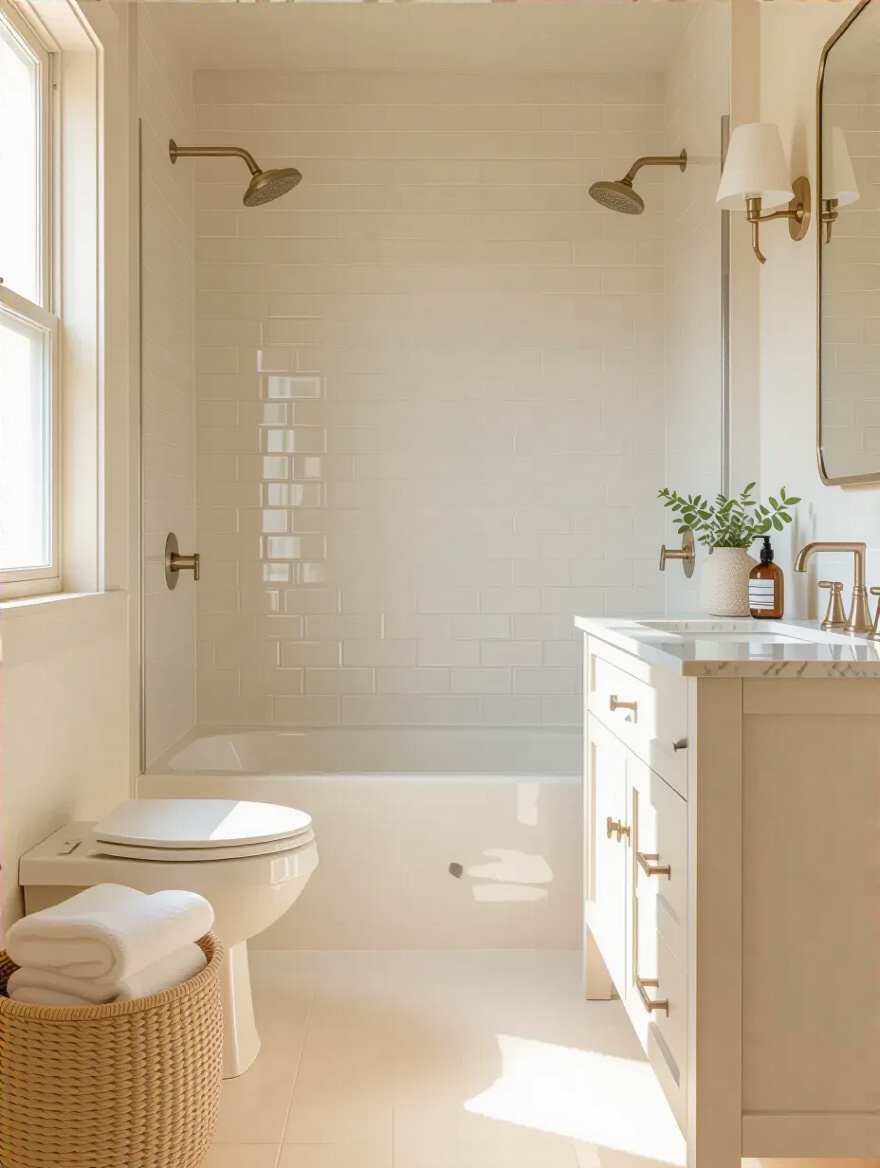
You can use different shades and tints of that same color across your walls, tiles, and accessories. The power of this approach is that it eliminates harsh visual stops. Your eye flows smoothly around the room, which makes it feel much larger and calmer. It creates a beautiful, unified canvas for your final touches.
This philosophy is most important when it comes to the softest things in the room.
23. Choose Monochromatic Towels and Accessories for Serenity
This is the shortcut I wish someone had told me years ago. Stop buying towels in a rainbow of colors. The most high-impact, luxurious thing you can do for your bathroom is to commit to one color for all your textiles. A stack of fluffy, all-white towels, a matching white bath mat, and white hand towels create an instant spa-like vibe. It looks clean, sophisticated, and incredibly serene.
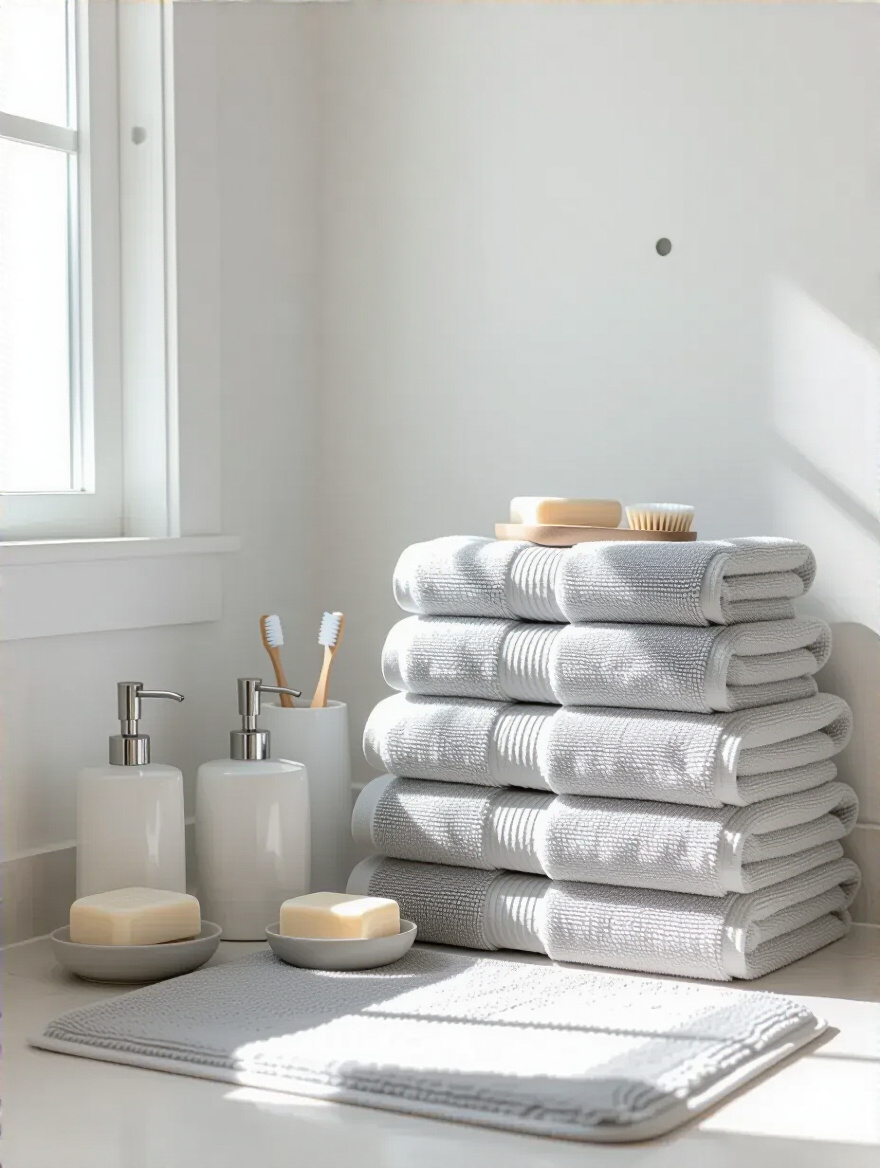
If all-white isn’t for you, choose another calming neutral like charcoal gray or soft beige. The secret to making a single color interesting is to vary the texture. Pair a thick, plush terrycloth bath towel with a waffle-weave hand towel and a nubby cotton bath mat. This creates rich, tactile layers that are an absolute delight for the senses.
Finally, let’s address the counter.
24. Organize Countertops with Decorative Trays and Apothecary Jars
Even in the most organized bathroom, you’ll have things that need to live on the countertop. The trick is to give them a home. A beautiful tray—whether it’s marble, wood, or mirrored—is the perfect tool for this. Grouping your daily items (a soap dispenser, a moisturizer bottle, a small cup for toothbrushes) on a tray instantly contains the clutter.
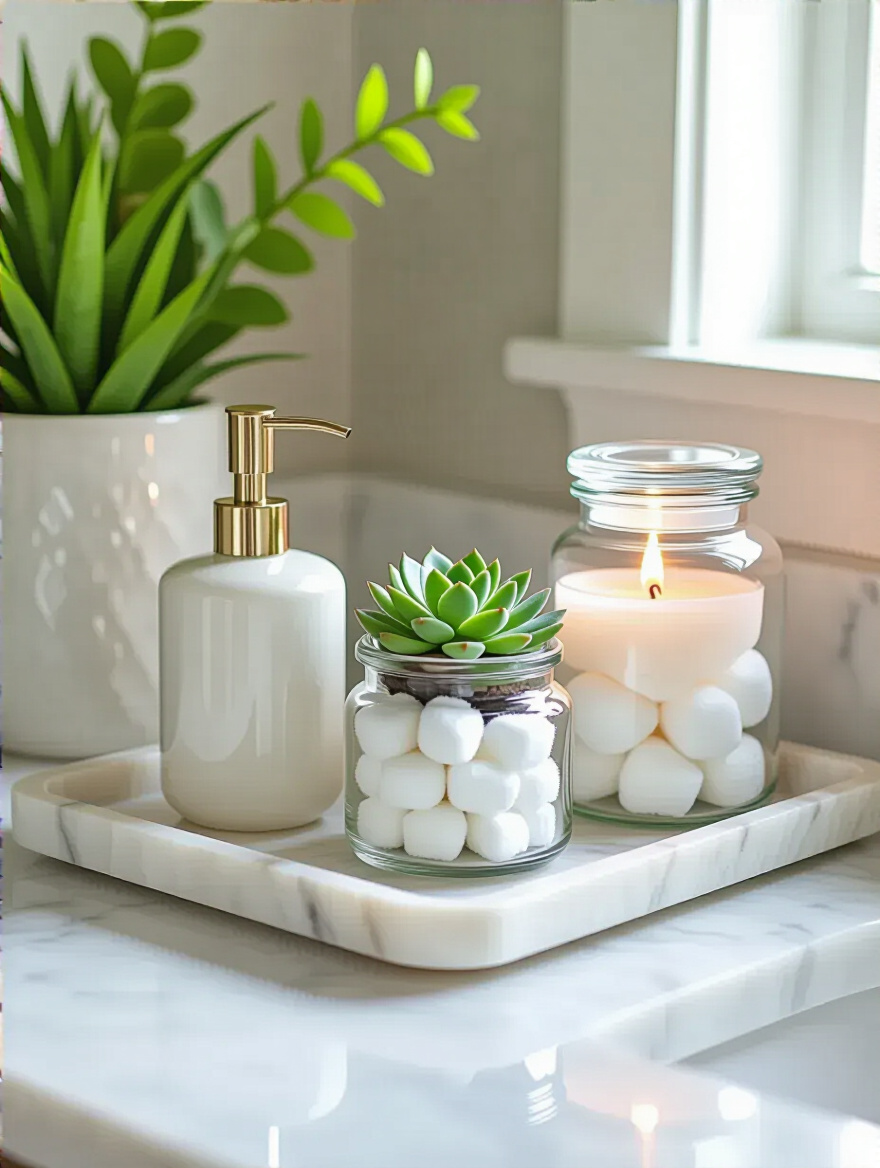
It turns a random assortment of objects into a curated vignette. For things like cotton balls, Q-tips, or bath salts, use beautiful glass apothecary jars. They keep things tidy and turn mundane supplies into a lovely display. This isn’t just about cleaning up; it’s about elevating the everyday and making your space feel like a boutique hotel.
It’s All About the Feeling
See? Transforming your small bathroom isn’t about some magic bullet product. It’s a collection of smart, thoughtful choices that all work together to create a feeling of spacious, calm luxury. It’s about respecting the small footprint by making every single element work hard, from the direction your door swings to the color of your towels.
Don’t get overwhelmed. You don’t have to do it all at once. Pick one thing from this list that resonates with you. Maybe you start by clearing your counters and getting a beautiful tray. Or maybe you finally swap out that dingy shower curtain for a sheet of sparkling glass. Start small, pay attention to how it makes the space feel, and let that feeling guide your next step. You have the power to turn that tiny, frustrating box into your own personal sanctuary.
